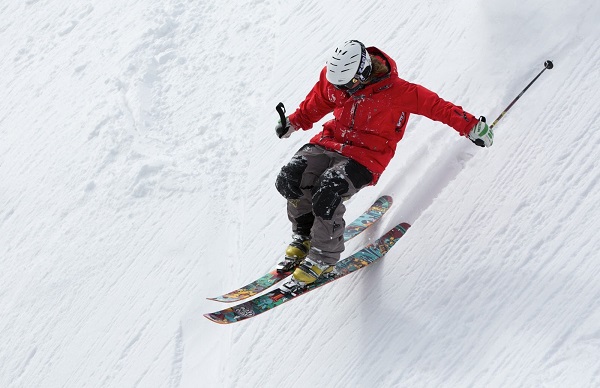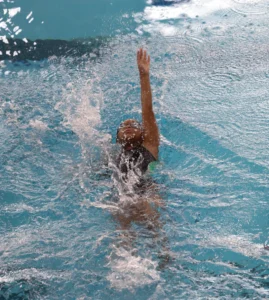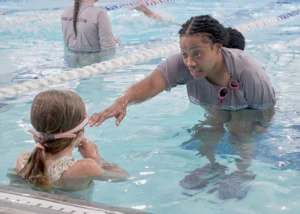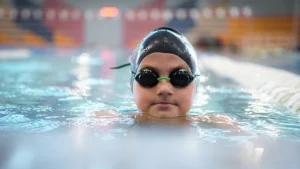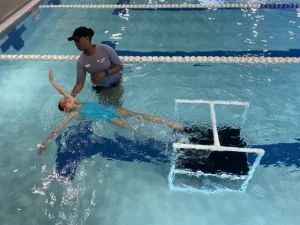How Swimming Improves Performance in Other Sports (and Vice Versa)
For many active people, the transition into chillier weather signifies the end of their sun-kissed sporty activities. That doesn’t have to be the case, though!
If you can look past the barrage of winter jackets and blinding white snowflakes, you’ll see winter doesn’t need to mean the end of all active endeavors.
Here are four sports—other than swimming, of course!—that can easily be done in the winter and will benefit you in the pool.
1. Cycling for Muscle Strength
Good old-fashioned biking provides a lot of stamina and muscle-building benefits, especially for the glutes, hamstrings, and quads. Also, don’t be fooled. Peddling isn’t exclusively for sunny days! With the right tires, you can glide over all kinds of winter terrain and bike trails.
Benefits of Cycling for Swimmers
Like swimming, cycling is a low-impact form of cardio and a great part of any well-rounded gym routine. Biking offers many of the same benefits as swimming and can increase your efficiency and effectiveness in the pool. (If you’re not too hot about cool winter cycling, you can always use an indoor stationary bike as well!)
Benefits of Swimming for Cyclists
Swimming helps any cyclist build a strong core and lengthen his or her hip flexors. Not to mention one’s breathing capacity can see gains as well. Many cyclists swim to expedite their active recovery stages soon after challenging races. Don’t underestimate the power of joining these two low-impact sports!
2. Skiing, Snowboarding, or Cross-Country Skiing for Lung Capacity
Did you know swimmers routinely have higher lung volumes than football players? For swimmers seeking to improve their lungs even more, look no further than downhill skiing or cross-country skiing! These are both great aerobic activities that can improve heart and lung function.
So, this winter, instead of indulging in too much hibernation, hit the slopes. Researchers have found that lifelong athletes who regularly practice aerobic exercises—that includes snowboarding—see major health benefits into their eighties and nineties.
Benefits of Skiing for Swimmers
What do cross-country skiing, alpine skiing, and downhill skiing all have in common? They’re all outdoors! Spending time at high altitudes can increase lung capacity, especially with access to all that clean air.
Benefits of Swimming for Skiers
Ski resorts are at a high altitude, and regular breathing exercises can help overcome any difficulties from that elevation. What better sport to practice breathing exercises than swimming?
Swimming promotes improved breathing through vigorous breathing patterns while exercising, especially during longer periods underwater.
Who knew high-altitude breathing and underwater breath control could complement each other so well?
3. Soccer for Core Stability
Every year, winter marks the end of soccer…right?
Nope! The loss of outdoor playing space can easily be overcome with indoor facilities. These open spaces can be used for official games, fun pickup sessions, or practice.
Training indoors during colder months can help players maintain key skills, including foot skills, ball movement, attacking, and defending. (And let’s not forget the most important skill: yelling “goooooooooal!”)
The skills acquired through swimming and playing soccer overlap in one significant way: building core stability.
Benefits of Soccer for Swimmers
Healthy core stability enables swimmers to maintain the correct body positions while traveling through the water. Core stability is crucial to spine strength and alignment during physical activity, such as walking, running, and swimming.
Benefits of Swimming for Soccer Players
Running puts a lot of stress on joints, but deep-water running reduces friction and allows individuals to work harder—without needlessly stressing their joints. Swimming is a great way for soccer players to improve their overall health, without needing to actually run and play soccer all day every day.
Core muscles are developed through swimming, and these muscles are important for soccer players. They lay the groundwork for posture, strength, power, coordination, and a reduced likelihood of injury.
The core stability gained through swimming also helps athletes use the body’s full range of motion. Swimming requires the entire body to move, and a strong core promotes all body movement to work in unison.
4. Ice Hockey for Cardio Stamina
Ice hockey is a great way to boost cardio stamina! Although hockey players seem as if they’re just sliding across the ice for short durations during a match, those periods of activity demand a lot of endurance and coordination.
Researchers have discovered these shorter periods of vigorous exercise are actually more efficient in increasing cardio stamina and endurance than moderate activity.
Benefits of Hockey for Swimmers
Short but more intense forms of exercise are part of high-intensity interval training (HIIT). Hockey moves between intense and more relaxed skating movements. These physically demanding routines can put your cardiovascular system to the test, but your stamina will improve over time…and if there’s one thing a swimmer always wants to improve, it’s stamina!
Benefits of Swimming for Hockey Players
Swimming is one of the most popular forms of cardiovascular fitness. Hockey players can easily enjoy swimming sessions in the off-season, but because of its low injury rate, swimming is also great before or after hockey matches.
Other Activities to Try This Winter
If these four sports aren’t your thing, consider any of these other winter-friendly activities:
-
- Squash
- Gymnastics
- Basketball
- Indoor tennis
- Indoor rock climbing
Just because it’s winter doesn’t mean your activity level needs to taper off. With a little creativity, the fitness options are practically endless!
If you’re looking to maximize your performance in another sport, consider jumping into swim lessons! It’s a great way to improve your muscle strength, coordination, and overall cardiovascular fitness. Join us now to start seeing the amazing results!
Can’t find the time in your busy schedule to make it to class? No problem! We can come to you. With our private at-home lessons, you get all the benefits of swim lessons…from the privacy of your own home.


